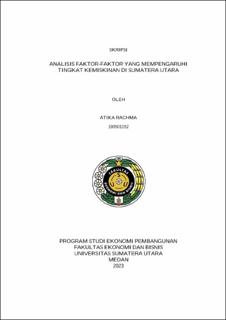Analisis Faktor-Faktor yang Mempengaruhi Tingkat Kemiskinan di Sumatera Utara
Abstract
This study aims to determine the effect of Gross Regional Domestic Product (GRDP), Human Development Index (HDI), Open Unemployment Rate (OOP), and Income Distribution on the poverty rate in North Sumatra from 1990-2019 both partially and simultaneously.
The type of research used in this research is descriptive research with a quantitative method approach. This research uses secondary data obtained in the form of time series data with a period of 30 years (1990-2019). The analysis model used is a multiple linear regression model with the OLS (Ordinary Least Square) method using statistical tests (t test, F test, and coefficient of determination (R²) test), as well as classical assumption tests (normality test, autocorrelation, heteroscedasticity, multicollinearity). The analytical tool used is the SPSS 22 program. The source of the data collected in this study comes from BPS (Central Bureau of Statistics).
The results of the analysis and data obtained from research on the Analysis of Factors Affecting the Poverty Level in North Sumatra show that, partially, the variables of GRDP and HDI have a negative and significant effect on the poverty rate in North Sumatra. Meanwhile, the TPT and Income Distribution variables have a positive and insignificant effect on the poverty rate in North Sumatra. Simultaneously, GRDP, HDI, TPT, and Income Distribution have a positive and significant effect on the poverty rate in North Sumatra. This study suggests the government to reduce the poverty rate by opening up enough jobs to absorb the number of workers, paying attention to the level of community income so that it is well distributed and does not experience income inequality, increasing GRDP and the quality of life of the community.
Collections
- Undergraduate Theses [2751]

